Investigation of MRSA Infection in Neonatal Intensive Care Unit: Genotypic and Culture Approach Reveals Outbreak and Drug Resistance
VerifiedAdded on 2023/04/25
|15
|3121
|424
AI Summary
A study was conducted on Methicillin-resistant Staphylococcus aureus (MRSA) infection in a neonatal intensive care unit. The study used genotype and culture approaches to investigate MRSA. The results showed positive MRSA colonization and identified the presence of MRSA strains through PCR and bioinformatics analysis. The study also assessed drug resistance, revealing that the MRSA strain was resistant to certain antibiotics. The findings indicated an outbreak of MRSA infection in the neonatal unit and transmission through carriers outside the hospital.
Contribute Materials
Your contribution can guide someone’s learning journey. Share your
documents today.
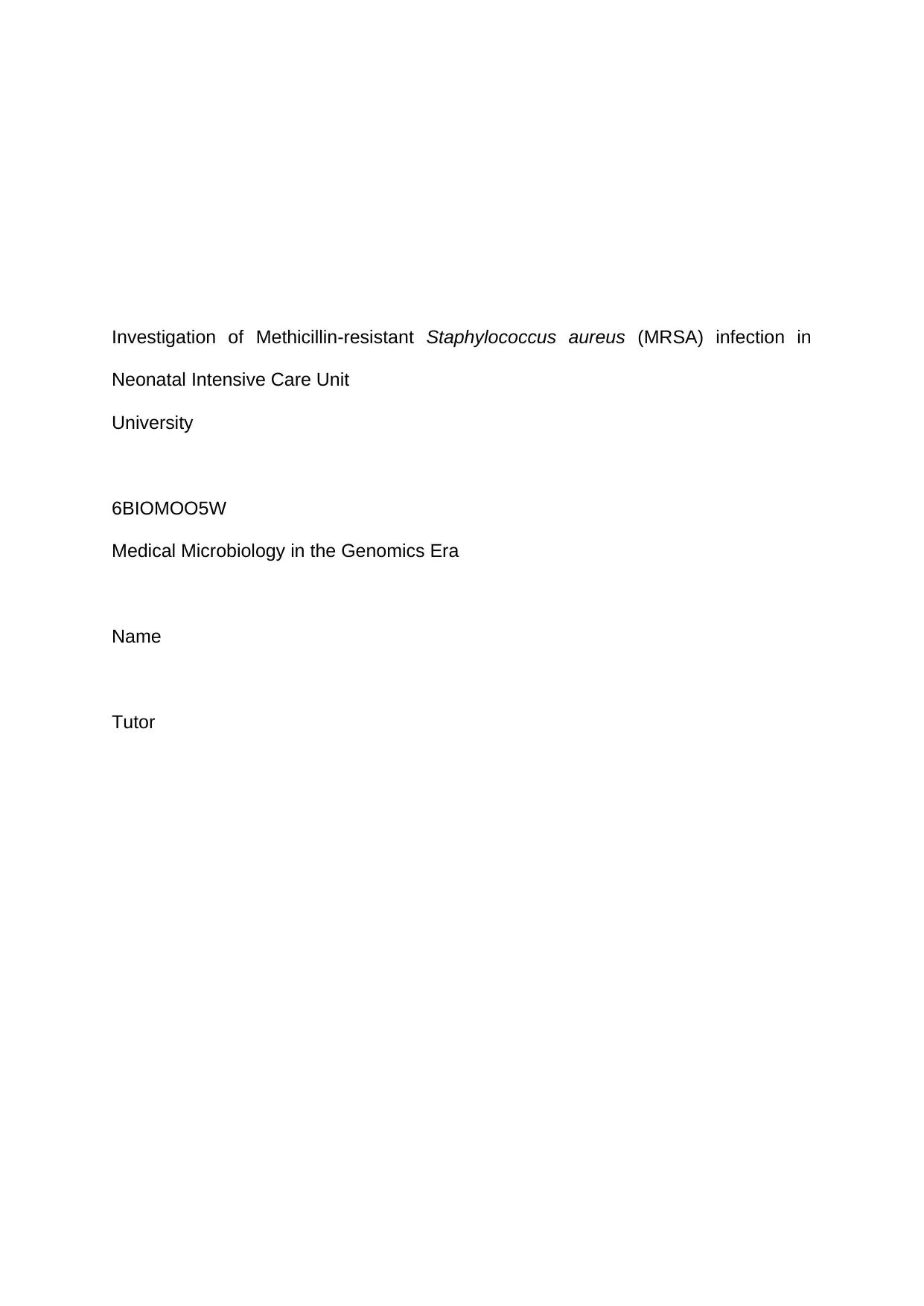
Investigation of Methicillin-resistant Staphylococcus aureus (MRSA) infection in
Neonatal Intensive Care Unit
University
6BIOMOO5W
Medical Microbiology in the Genomics Era
Name
Tutor
Neonatal Intensive Care Unit
University
6BIOMOO5W
Medical Microbiology in the Genomics Era
Name
Tutor
Secure Best Marks with AI Grader
Need help grading? Try our AI Grader for instant feedback on your assignments.
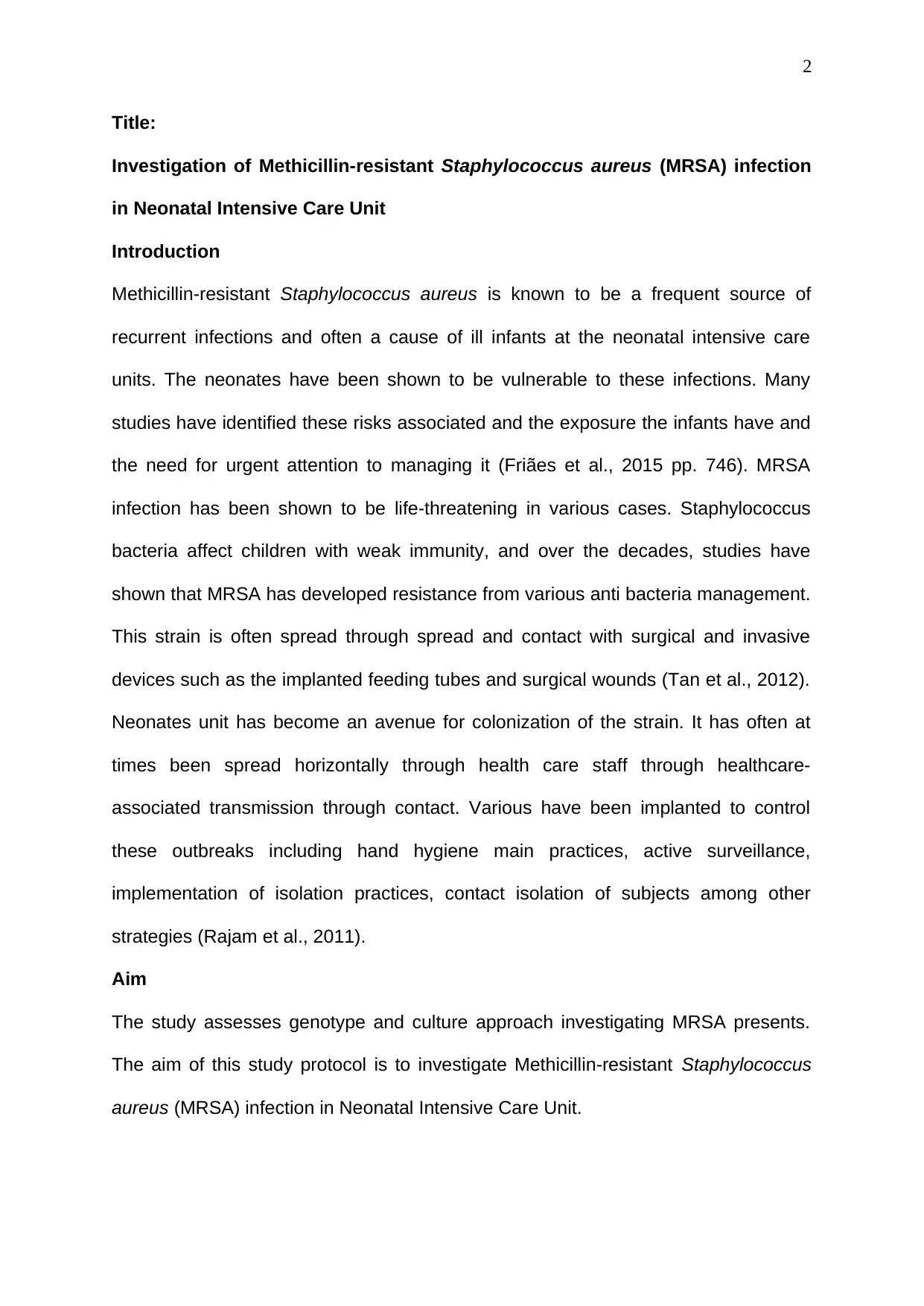
2
Title:
Investigation of Methicillin-resistant Staphylococcus aureus (MRSA) infection
in Neonatal Intensive Care Unit
Introduction
Methicillin-resistant Staphylococcus aureus is known to be a frequent source of
recurrent infections and often a cause of ill infants at the neonatal intensive care
units. The neonates have been shown to be vulnerable to these infections. Many
studies have identified these risks associated and the exposure the infants have and
the need for urgent attention to managing it (Friães et al., 2015 pp. 746). MRSA
infection has been shown to be life-threatening in various cases. Staphylococcus
bacteria affect children with weak immunity, and over the decades, studies have
shown that MRSA has developed resistance from various anti bacteria management.
This strain is often spread through spread and contact with surgical and invasive
devices such as the implanted feeding tubes and surgical wounds (Tan et al., 2012).
Neonates unit has become an avenue for colonization of the strain. It has often at
times been spread horizontally through health care staff through healthcare-
associated transmission through contact. Various have been implanted to control
these outbreaks including hand hygiene main practices, active surveillance,
implementation of isolation practices, contact isolation of subjects among other
strategies (Rajam et al., 2011).
Aim
The study assesses genotype and culture approach investigating MRSA presents.
The aim of this study protocol is to investigate Methicillin-resistant Staphylococcus
aureus (MRSA) infection in Neonatal Intensive Care Unit.
Title:
Investigation of Methicillin-resistant Staphylococcus aureus (MRSA) infection
in Neonatal Intensive Care Unit
Introduction
Methicillin-resistant Staphylococcus aureus is known to be a frequent source of
recurrent infections and often a cause of ill infants at the neonatal intensive care
units. The neonates have been shown to be vulnerable to these infections. Many
studies have identified these risks associated and the exposure the infants have and
the need for urgent attention to managing it (Friães et al., 2015 pp. 746). MRSA
infection has been shown to be life-threatening in various cases. Staphylococcus
bacteria affect children with weak immunity, and over the decades, studies have
shown that MRSA has developed resistance from various anti bacteria management.
This strain is often spread through spread and contact with surgical and invasive
devices such as the implanted feeding tubes and surgical wounds (Tan et al., 2012).
Neonates unit has become an avenue for colonization of the strain. It has often at
times been spread horizontally through health care staff through healthcare-
associated transmission through contact. Various have been implanted to control
these outbreaks including hand hygiene main practices, active surveillance,
implementation of isolation practices, contact isolation of subjects among other
strategies (Rajam et al., 2011).
Aim
The study assesses genotype and culture approach investigating MRSA presents.
The aim of this study protocol is to investigate Methicillin-resistant Staphylococcus
aureus (MRSA) infection in Neonatal Intensive Care Unit.
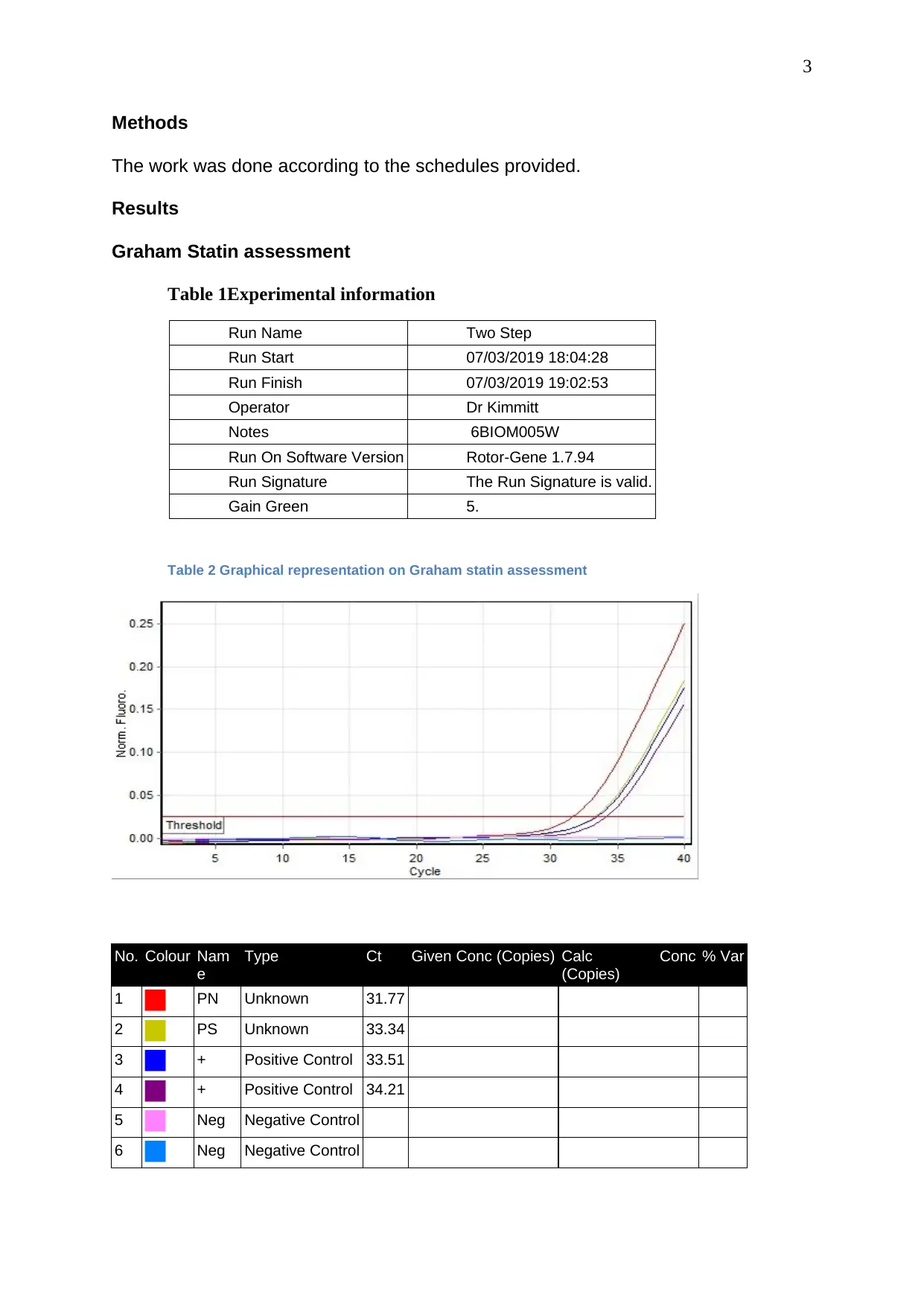
3
Methods
The work was done according to the schedules provided.
Results
Graham Statin assessment
Table 1Experimental information
Run Name Two Step
Run Start 07/03/2019 18:04:28
Run Finish 07/03/2019 19:02:53
Operator Dr Kimmitt
Notes 6BIOM005W
Run On Software Version Rotor-Gene 1.7.94
Run Signature The Run Signature is valid.
Gain Green 5.
Table 2 Graphical representation on Graham statin assessment
No. Colour Nam
e
Type Ct Given Conc (Copies) Calc Conc
(Copies)
% Var
1 PN Unknown 31.77
2 PS Unknown 33.34
3 + Positive Control 33.51
4 + Positive Control 34.21
5 Neg Negative Control
6 Neg Negative Control
Methods
The work was done according to the schedules provided.
Results
Graham Statin assessment
Table 1Experimental information
Run Name Two Step
Run Start 07/03/2019 18:04:28
Run Finish 07/03/2019 19:02:53
Operator Dr Kimmitt
Notes 6BIOM005W
Run On Software Version Rotor-Gene 1.7.94
Run Signature The Run Signature is valid.
Gain Green 5.
Table 2 Graphical representation on Graham statin assessment
No. Colour Nam
e
Type Ct Given Conc (Copies) Calc Conc
(Copies)
% Var
1 PN Unknown 31.77
2 PS Unknown 33.34
3 + Positive Control 33.51
4 + Positive Control 34.21
5 Neg Negative Control
6 Neg Negative Control
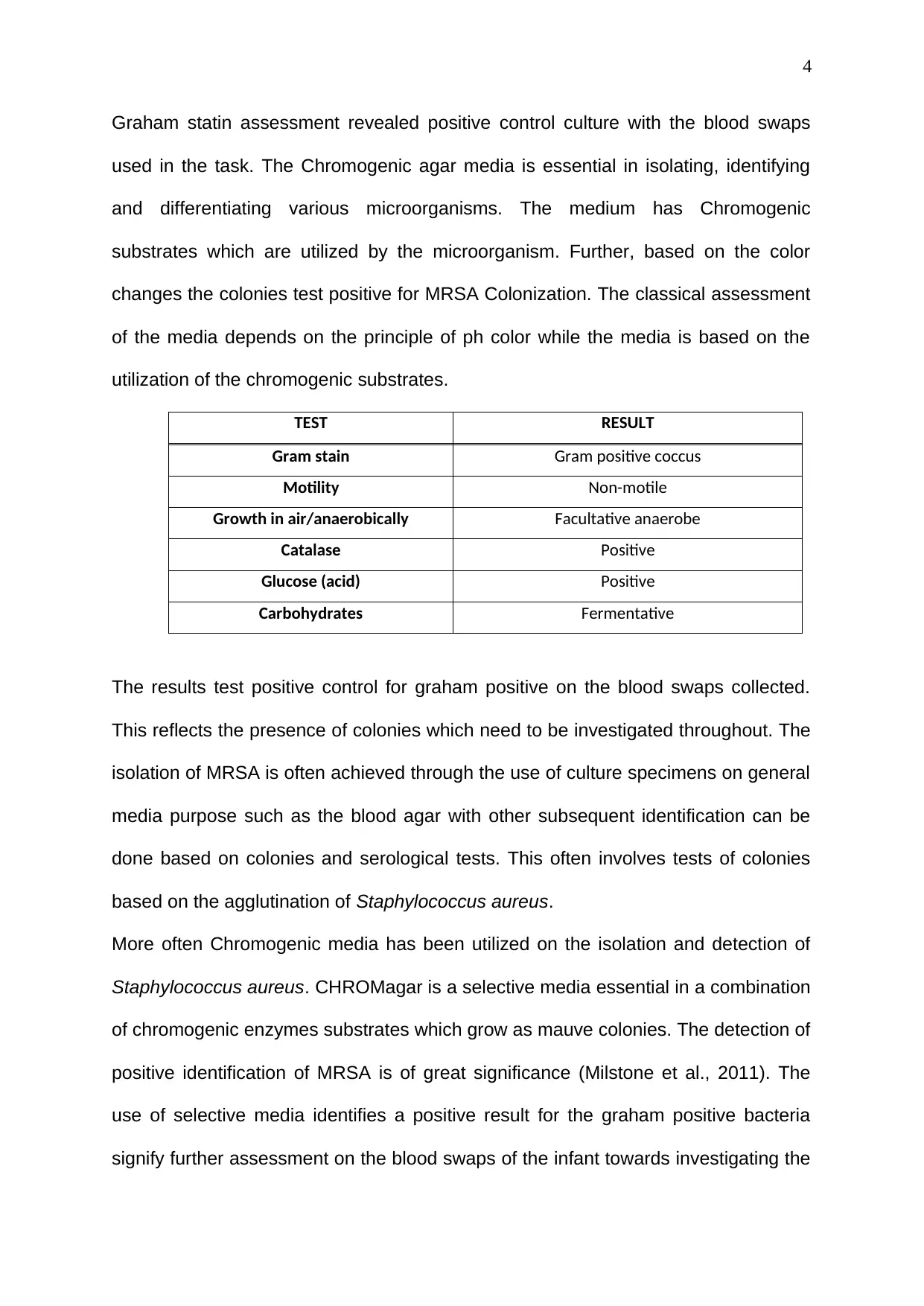
4
Graham statin assessment revealed positive control culture with the blood swaps
used in the task. The Chromogenic agar media is essential in isolating, identifying
and differentiating various microorganisms. The medium has Chromogenic
substrates which are utilized by the microorganism. Further, based on the color
changes the colonies test positive for MRSA Colonization. The classical assessment
of the media depends on the principle of ph color while the media is based on the
utilization of the chromogenic substrates.
TEST RESULT
Gram stain Gram positive coccus
Motility Non-motile
Growth in air/anaerobically Facultative anaerobe
Catalase Positive
Glucose (acid) Positive
Carbohydrates Fermentative
The results test positive control for graham positive on the blood swaps collected.
This reflects the presence of colonies which need to be investigated throughout. The
isolation of MRSA is often achieved through the use of culture specimens on general
media purpose such as the blood agar with other subsequent identification can be
done based on colonies and serological tests. This often involves tests of colonies
based on the agglutination of Staphylococcus aureus.
More often Chromogenic media has been utilized on the isolation and detection of
Staphylococcus aureus. CHROMagar is a selective media essential in a combination
of chromogenic enzymes substrates which grow as mauve colonies. The detection of
positive identification of MRSA is of great significance (Milstone et al., 2011). The
use of selective media identifies a positive result for the graham positive bacteria
signify further assessment on the blood swaps of the infant towards investigating the
Graham statin assessment revealed positive control culture with the blood swaps
used in the task. The Chromogenic agar media is essential in isolating, identifying
and differentiating various microorganisms. The medium has Chromogenic
substrates which are utilized by the microorganism. Further, based on the color
changes the colonies test positive for MRSA Colonization. The classical assessment
of the media depends on the principle of ph color while the media is based on the
utilization of the chromogenic substrates.
TEST RESULT
Gram stain Gram positive coccus
Motility Non-motile
Growth in air/anaerobically Facultative anaerobe
Catalase Positive
Glucose (acid) Positive
Carbohydrates Fermentative
The results test positive control for graham positive on the blood swaps collected.
This reflects the presence of colonies which need to be investigated throughout. The
isolation of MRSA is often achieved through the use of culture specimens on general
media purpose such as the blood agar with other subsequent identification can be
done based on colonies and serological tests. This often involves tests of colonies
based on the agglutination of Staphylococcus aureus.
More often Chromogenic media has been utilized on the isolation and detection of
Staphylococcus aureus. CHROMagar is a selective media essential in a combination
of chromogenic enzymes substrates which grow as mauve colonies. The detection of
positive identification of MRSA is of great significance (Milstone et al., 2011). The
use of selective media identifies a positive result for the graham positive bacteria
signify further assessment on the blood swaps of the infant towards investigating the
Secure Best Marks with AI Grader
Need help grading? Try our AI Grader for instant feedback on your assignments.
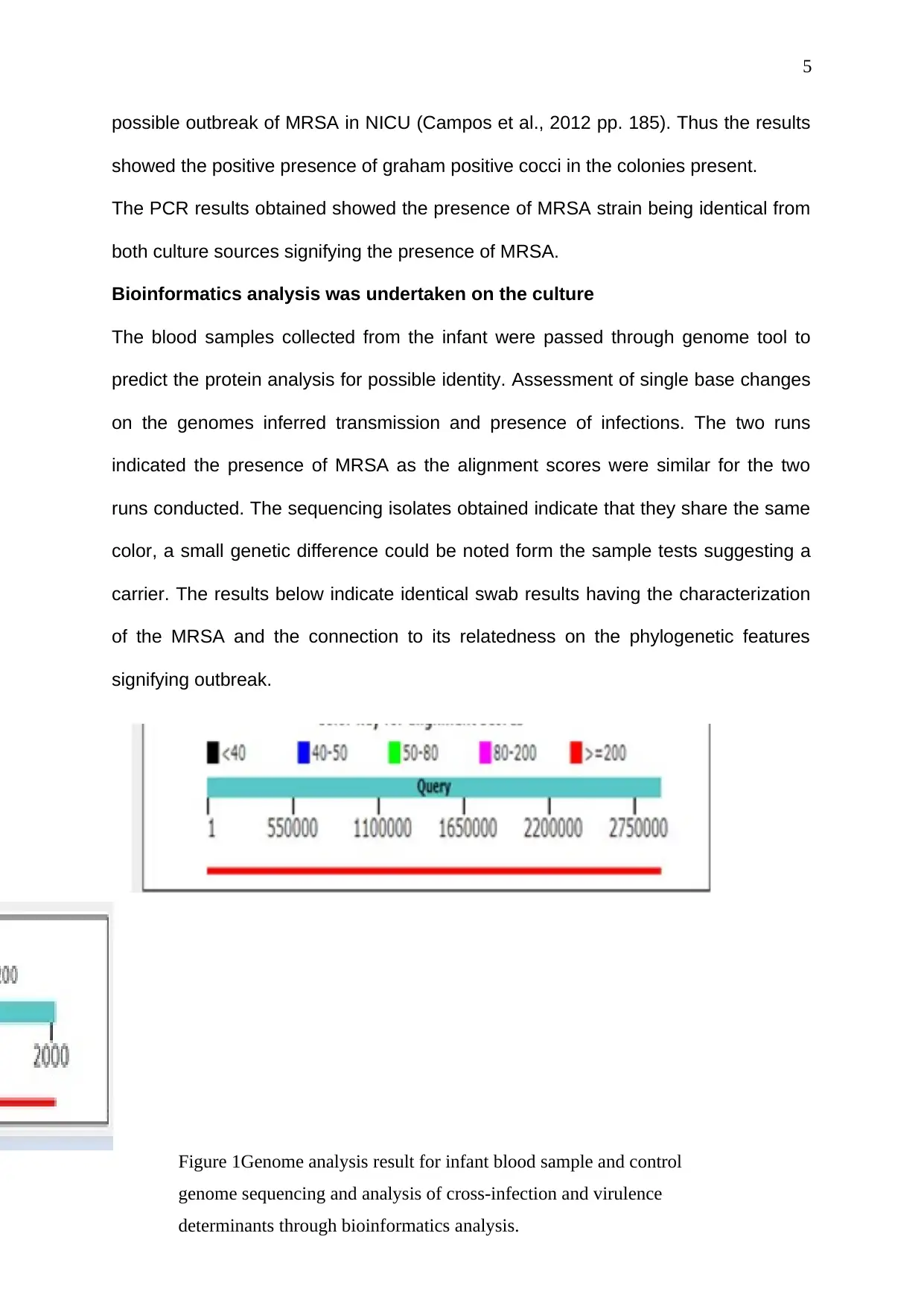
5
possible outbreak of MRSA in NICU (Campos et al., 2012 pp. 185). Thus the results
showed the positive presence of graham positive cocci in the colonies present.
The PCR results obtained showed the presence of MRSA strain being identical from
both culture sources signifying the presence of MRSA.
Bioinformatics analysis was undertaken on the culture
The blood samples collected from the infant were passed through genome tool to
predict the protein analysis for possible identity. Assessment of single base changes
on the genomes inferred transmission and presence of infections. The two runs
indicated the presence of MRSA as the alignment scores were similar for the two
runs conducted. The sequencing isolates obtained indicate that they share the same
color, a small genetic difference could be noted form the sample tests suggesting a
carrier. The results below indicate identical swab results having the characterization
of the MRSA and the connection to its relatedness on the phylogenetic features
signifying outbreak.
Figure 1Genome analysis result for infant blood sample and control
genome sequencing and analysis of cross-infection and virulence
determinants through bioinformatics analysis.
possible outbreak of MRSA in NICU (Campos et al., 2012 pp. 185). Thus the results
showed the positive presence of graham positive cocci in the colonies present.
The PCR results obtained showed the presence of MRSA strain being identical from
both culture sources signifying the presence of MRSA.
Bioinformatics analysis was undertaken on the culture
The blood samples collected from the infant were passed through genome tool to
predict the protein analysis for possible identity. Assessment of single base changes
on the genomes inferred transmission and presence of infections. The two runs
indicated the presence of MRSA as the alignment scores were similar for the two
runs conducted. The sequencing isolates obtained indicate that they share the same
color, a small genetic difference could be noted form the sample tests suggesting a
carrier. The results below indicate identical swab results having the characterization
of the MRSA and the connection to its relatedness on the phylogenetic features
signifying outbreak.
Figure 1Genome analysis result for infant blood sample and control
genome sequencing and analysis of cross-infection and virulence
determinants through bioinformatics analysis.
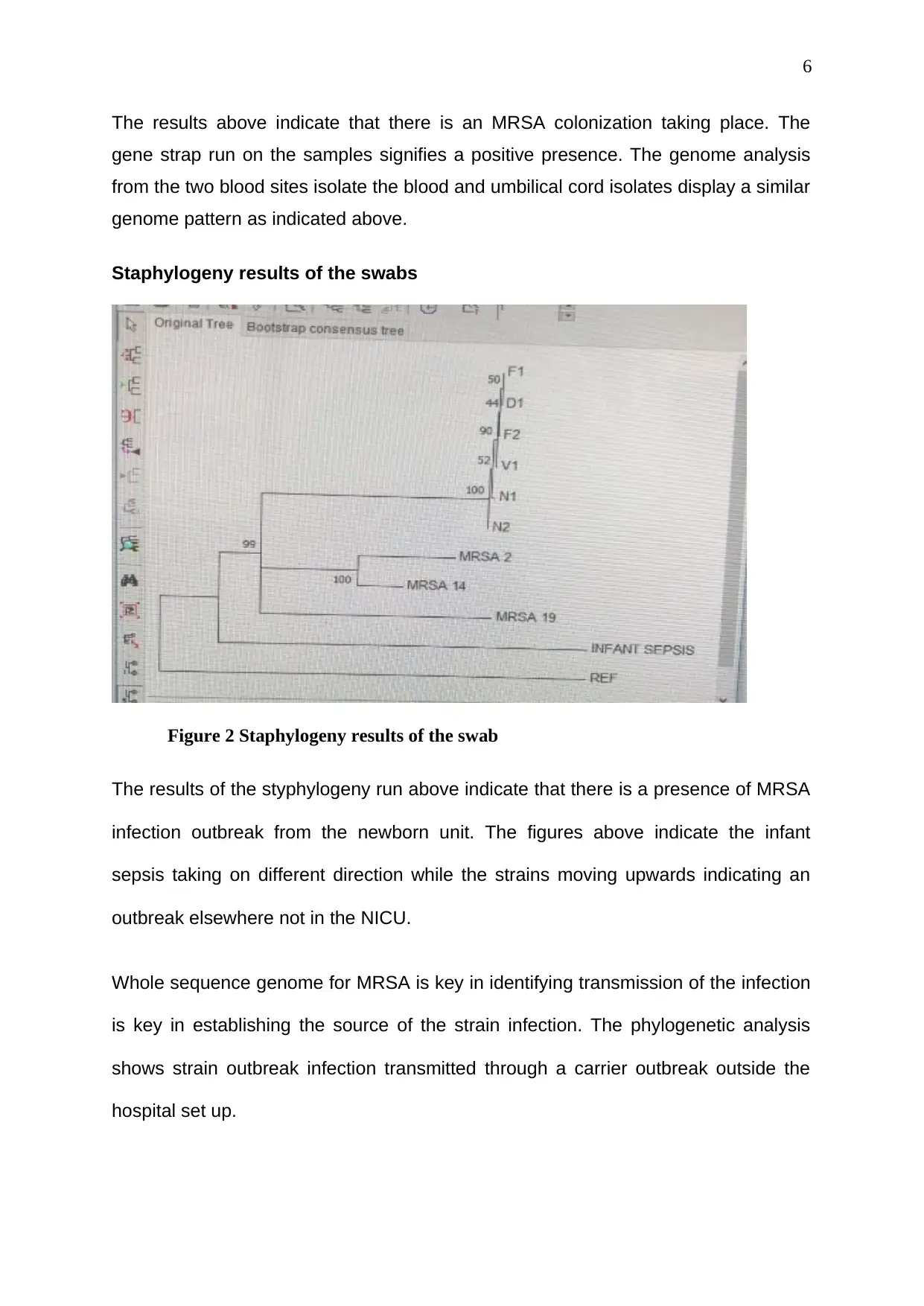
6
The results above indicate that there is an MRSA colonization taking place. The
gene strap run on the samples signifies a positive presence. The genome analysis
from the two blood sites isolate the blood and umbilical cord isolates display a similar
genome pattern as indicated above.
Staphylogeny results of the swabs
Figure 2 Staphylogeny results of the swab
The results of the styphylogeny run above indicate that there is a presence of MRSA
infection outbreak from the newborn unit. The figures above indicate the infant
sepsis taking on different direction while the strains moving upwards indicating an
outbreak elsewhere not in the NICU.
Whole sequence genome for MRSA is key in identifying transmission of the infection
is key in establishing the source of the strain infection. The phylogenetic analysis
shows strain outbreak infection transmitted through a carrier outbreak outside the
hospital set up.
The results above indicate that there is an MRSA colonization taking place. The
gene strap run on the samples signifies a positive presence. The genome analysis
from the two blood sites isolate the blood and umbilical cord isolates display a similar
genome pattern as indicated above.
Staphylogeny results of the swabs
Figure 2 Staphylogeny results of the swab
The results of the styphylogeny run above indicate that there is a presence of MRSA
infection outbreak from the newborn unit. The figures above indicate the infant
sepsis taking on different direction while the strains moving upwards indicating an
outbreak elsewhere not in the NICU.
Whole sequence genome for MRSA is key in identifying transmission of the infection
is key in establishing the source of the strain infection. The phylogenetic analysis
shows strain outbreak infection transmitted through a carrier outbreak outside the
hospital set up.
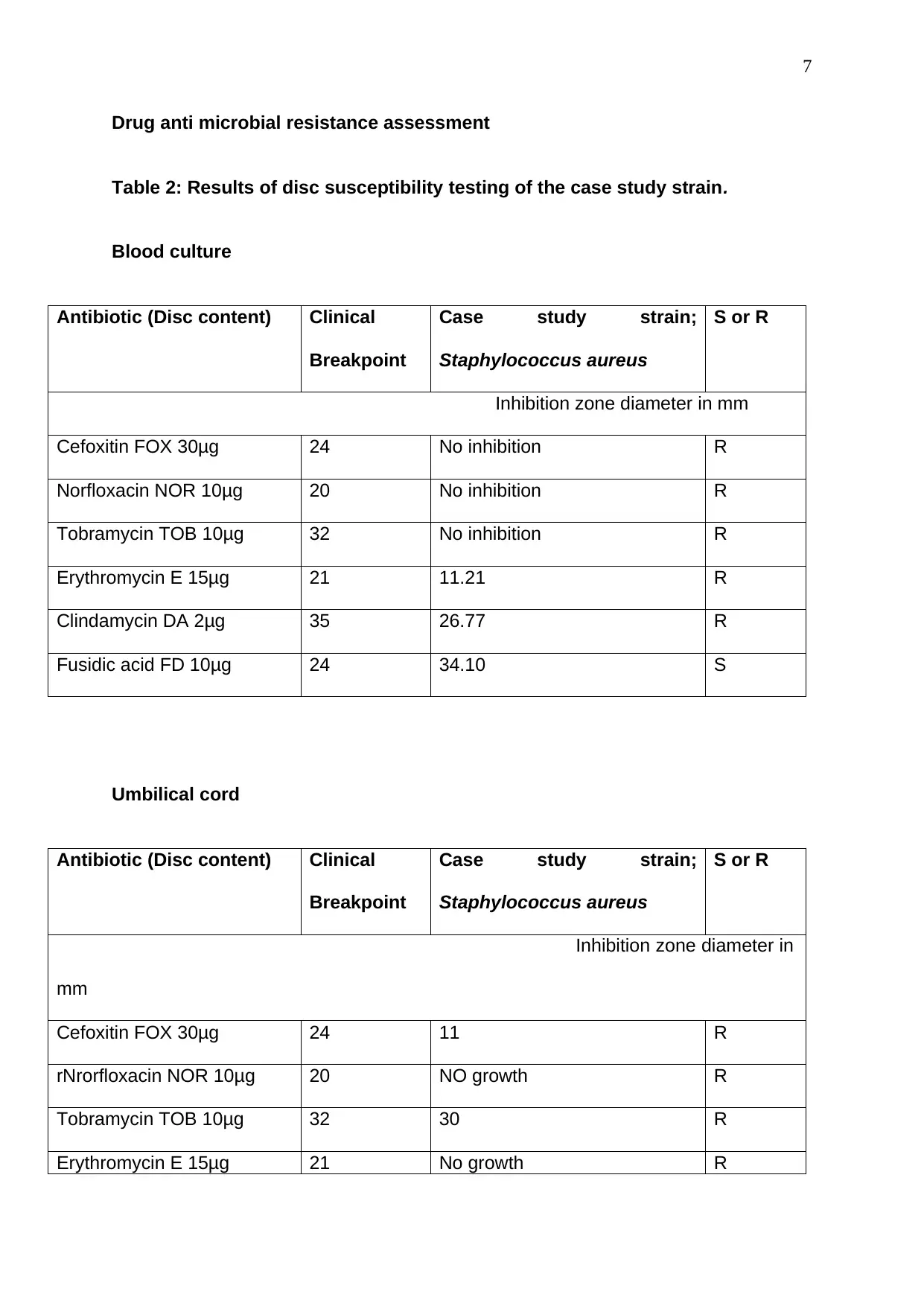
7
Drug anti microbial resistance assessment
Table 2: Results of disc susceptibility testing of the case study strain.
Blood culture
Antibiotic (Disc content) Clinical
Breakpoint
Case study strain;
Staphylococcus aureus
S or R
Inhibition zone diameter in mm
Cefoxitin FOX 30μg 24 No inhibition R
Norfloxacin NOR 10μg 20 No inhibition R
Tobramycin TOB 10μg 32 No inhibition R
Erythromycin E 15μg 21 11.21 R
Clindamycin DA 2μg 35 26.77 R
Fusidic acid FD 10μg 24 34.10 S
Umbilical cord
Antibiotic (Disc content) Clinical
Breakpoint
Case study strain;
Staphylococcus aureus
S or R
Inhibition zone diameter in
mm
Cefoxitin FOX 30μg 24 11 R
rNrorfloxacin NOR 10μg 20 NO growth R
Tobramycin TOB 10μg 32 30 R
Erythromycin E 15μg 21 No growth R
Drug anti microbial resistance assessment
Table 2: Results of disc susceptibility testing of the case study strain.
Blood culture
Antibiotic (Disc content) Clinical
Breakpoint
Case study strain;
Staphylococcus aureus
S or R
Inhibition zone diameter in mm
Cefoxitin FOX 30μg 24 No inhibition R
Norfloxacin NOR 10μg 20 No inhibition R
Tobramycin TOB 10μg 32 No inhibition R
Erythromycin E 15μg 21 11.21 R
Clindamycin DA 2μg 35 26.77 R
Fusidic acid FD 10μg 24 34.10 S
Umbilical cord
Antibiotic (Disc content) Clinical
Breakpoint
Case study strain;
Staphylococcus aureus
S or R
Inhibition zone diameter in
mm
Cefoxitin FOX 30μg 24 11 R
rNrorfloxacin NOR 10μg 20 NO growth R
Tobramycin TOB 10μg 32 30 R
Erythromycin E 15μg 21 No growth R
Paraphrase This Document
Need a fresh take? Get an instant paraphrase of this document with our AI Paraphraser
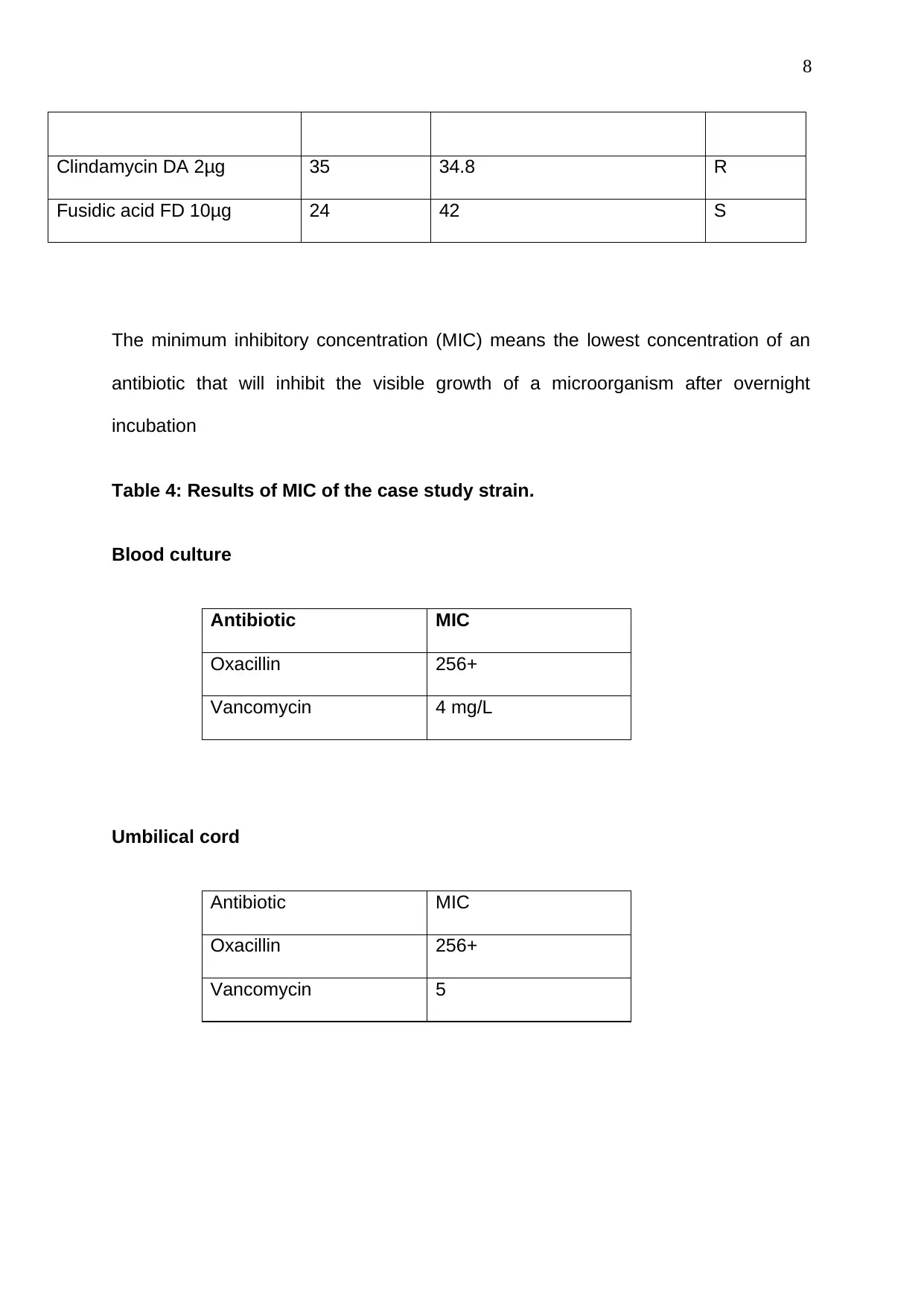
8
Clindamycin DA 2μg 35 34.8 R
Fusidic acid FD 10μg 24 42 S
The minimum inhibitory concentration (MIC) means the lowest concentration of an
antibiotic that will inhibit the visible growth of a microorganism after overnight
incubation
Table 4: Results of MIC of the case study strain.
Blood culture
Antibiotic MIC
Oxacillin 256+
Vancomycin 4 mg/L
Umbilical cord
Antibiotic MIC
Oxacillin 256+
Vancomycin 5
Clindamycin DA 2μg 35 34.8 R
Fusidic acid FD 10μg 24 42 S
The minimum inhibitory concentration (MIC) means the lowest concentration of an
antibiotic that will inhibit the visible growth of a microorganism after overnight
incubation
Table 4: Results of MIC of the case study strain.
Blood culture
Antibiotic MIC
Oxacillin 256+
Vancomycin 4 mg/L
Umbilical cord
Antibiotic MIC
Oxacillin 256+
Vancomycin 5
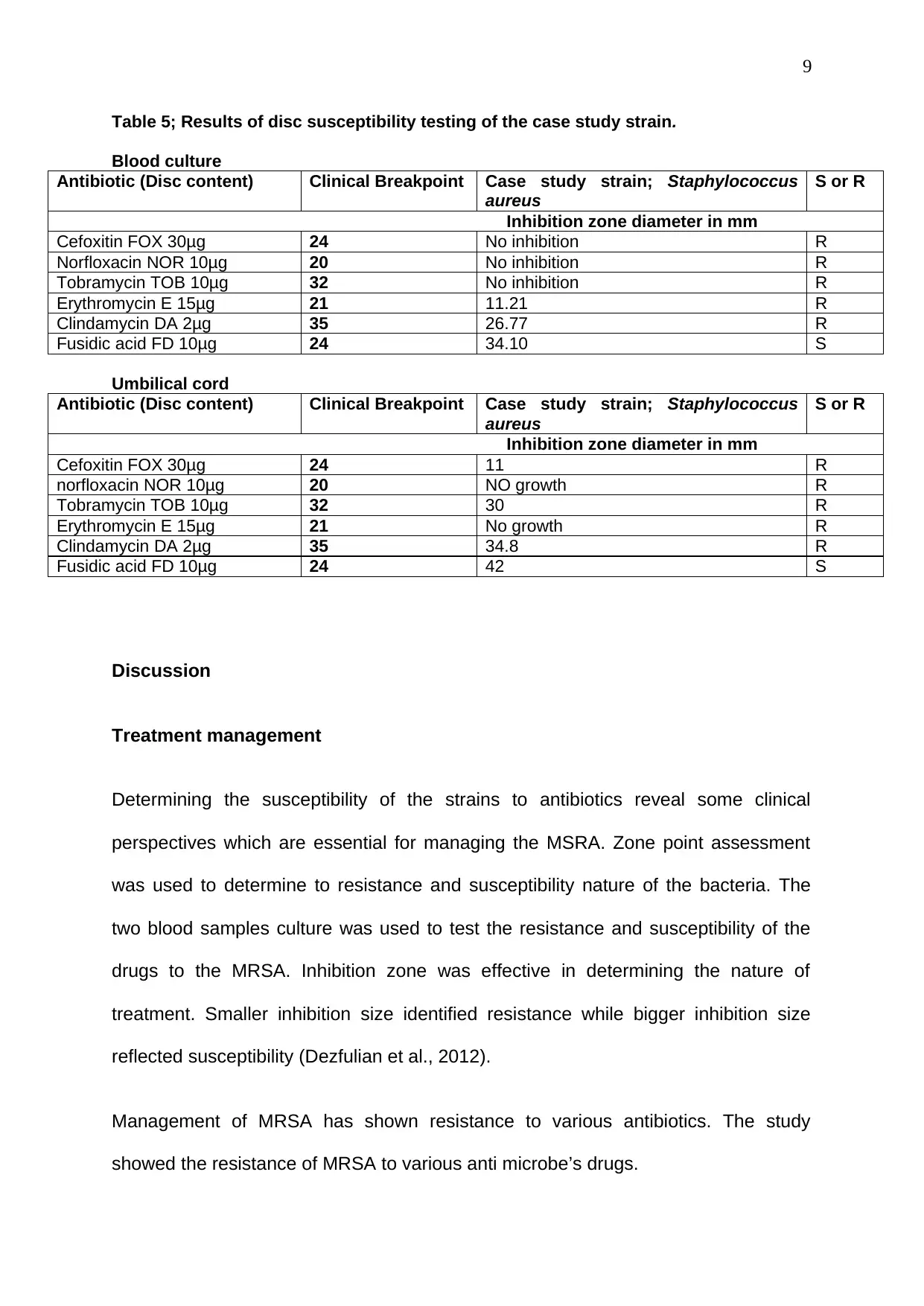
9
Table 5; Results of disc susceptibility testing of the case study strain.
Blood culture
Antibiotic (Disc content) Clinical Breakpoint Case study strain; Staphylococcus
aureus
S or R
Inhibition zone diameter in mm
Cefoxitin FOX 30μg 24 No inhibition R
Norfloxacin NOR 10μg 20 No inhibition R
Tobramycin TOB 10μg 32 No inhibition R
Erythromycin E 15μg 21 11.21 R
Clindamycin DA 2μg 35 26.77 R
Fusidic acid FD 10μg 24 34.10 S
Umbilical cord
Antibiotic (Disc content) Clinical Breakpoint Case study strain; Staphylococcus
aureus
S or R
Inhibition zone diameter in mm
Cefoxitin FOX 30μg 24 11 R
norfloxacin NOR 10μg 20 NO growth R
Tobramycin TOB 10μg 32 30 R
Erythromycin E 15μg 21 No growth R
Clindamycin DA 2μg 35 34.8 R
Fusidic acid FD 10μg 24 42 S
Discussion
Treatment management
Determining the susceptibility of the strains to antibiotics reveal some clinical
perspectives which are essential for managing the MSRA. Zone point assessment
was used to determine to resistance and susceptibility nature of the bacteria. The
two blood samples culture was used to test the resistance and susceptibility of the
drugs to the MRSA. Inhibition zone was effective in determining the nature of
treatment. Smaller inhibition size identified resistance while bigger inhibition size
reflected susceptibility (Dezfulian et al., 2012).
Management of MRSA has shown resistance to various antibiotics. The study
showed the resistance of MRSA to various anti microbe’s drugs.
Table 5; Results of disc susceptibility testing of the case study strain.
Blood culture
Antibiotic (Disc content) Clinical Breakpoint Case study strain; Staphylococcus
aureus
S or R
Inhibition zone diameter in mm
Cefoxitin FOX 30μg 24 No inhibition R
Norfloxacin NOR 10μg 20 No inhibition R
Tobramycin TOB 10μg 32 No inhibition R
Erythromycin E 15μg 21 11.21 R
Clindamycin DA 2μg 35 26.77 R
Fusidic acid FD 10μg 24 34.10 S
Umbilical cord
Antibiotic (Disc content) Clinical Breakpoint Case study strain; Staphylococcus
aureus
S or R
Inhibition zone diameter in mm
Cefoxitin FOX 30μg 24 11 R
norfloxacin NOR 10μg 20 NO growth R
Tobramycin TOB 10μg 32 30 R
Erythromycin E 15μg 21 No growth R
Clindamycin DA 2μg 35 34.8 R
Fusidic acid FD 10μg 24 42 S
Discussion
Treatment management
Determining the susceptibility of the strains to antibiotics reveal some clinical
perspectives which are essential for managing the MSRA. Zone point assessment
was used to determine to resistance and susceptibility nature of the bacteria. The
two blood samples culture was used to test the resistance and susceptibility of the
drugs to the MRSA. Inhibition zone was effective in determining the nature of
treatment. Smaller inhibition size identified resistance while bigger inhibition size
reflected susceptibility (Dezfulian et al., 2012).
Management of MRSA has shown resistance to various antibiotics. The study
showed the resistance of MRSA to various anti microbe’s drugs.
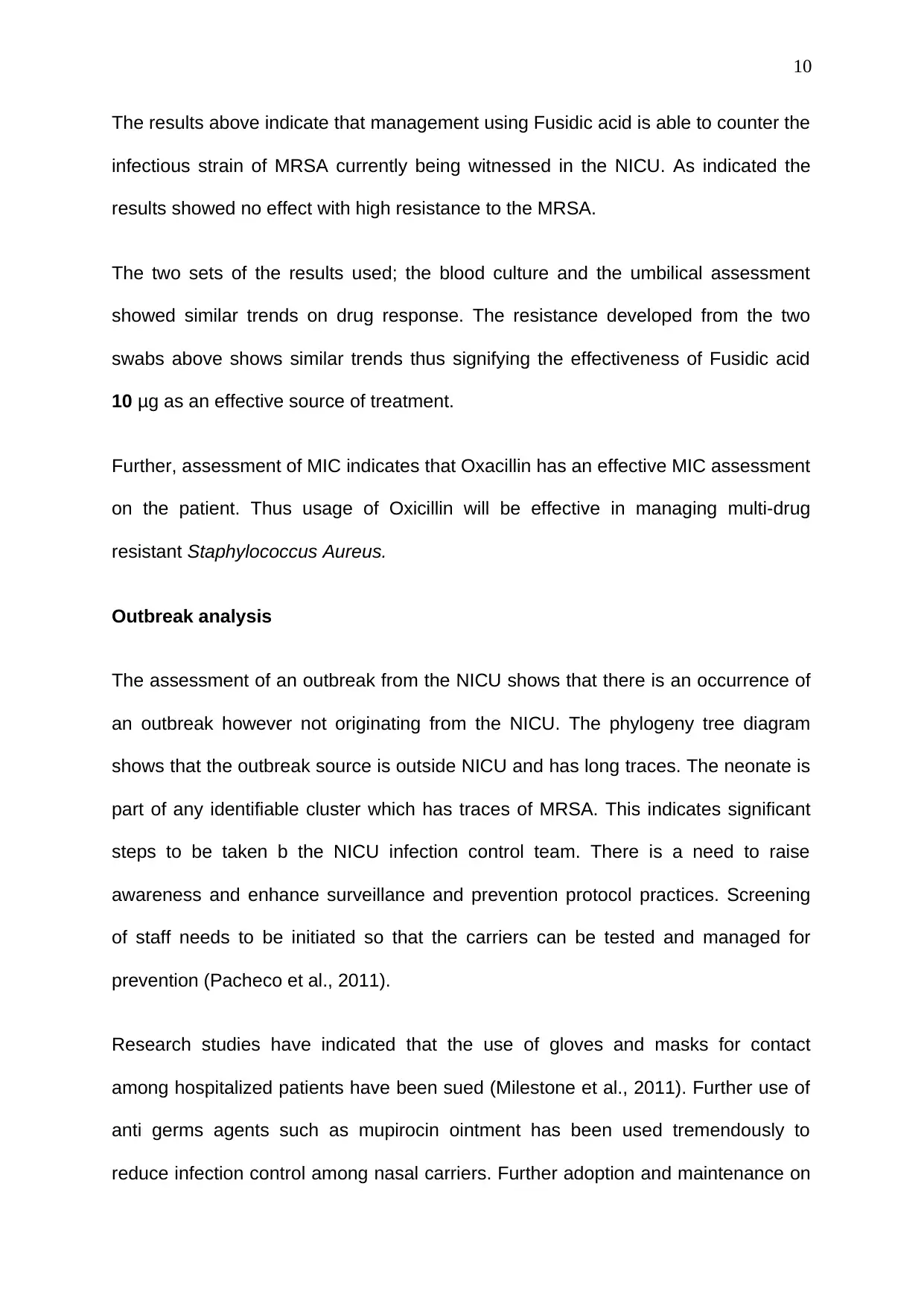
10
The results above indicate that management using Fusidic acid is able to counter the
infectious strain of MRSA currently being witnessed in the NICU. As indicated the
results showed no effect with high resistance to the MRSA.
The two sets of the results used; the blood culture and the umbilical assessment
showed similar trends on drug response. The resistance developed from the two
swabs above shows similar trends thus signifying the effectiveness of Fusidic acid
10 μg as an effective source of treatment.
Further, assessment of MIC indicates that Oxacillin has an effective MIC assessment
on the patient. Thus usage of Oxicillin will be effective in managing multi-drug
resistant Staphylococcus Aureus.
Outbreak analysis
The assessment of an outbreak from the NICU shows that there is an occurrence of
an outbreak however not originating from the NICU. The phylogeny tree diagram
shows that the outbreak source is outside NICU and has long traces. The neonate is
part of any identifiable cluster which has traces of MRSA. This indicates significant
steps to be taken b the NICU infection control team. There is a need to raise
awareness and enhance surveillance and prevention protocol practices. Screening
of staff needs to be initiated so that the carriers can be tested and managed for
prevention (Pacheco et al., 2011).
Research studies have indicated that the use of gloves and masks for contact
among hospitalized patients have been sued (Milestone et al., 2011). Further use of
anti germs agents such as mupirocin ointment has been used tremendously to
reduce infection control among nasal carriers. Further adoption and maintenance on
The results above indicate that management using Fusidic acid is able to counter the
infectious strain of MRSA currently being witnessed in the NICU. As indicated the
results showed no effect with high resistance to the MRSA.
The two sets of the results used; the blood culture and the umbilical assessment
showed similar trends on drug response. The resistance developed from the two
swabs above shows similar trends thus signifying the effectiveness of Fusidic acid
10 μg as an effective source of treatment.
Further, assessment of MIC indicates that Oxacillin has an effective MIC assessment
on the patient. Thus usage of Oxicillin will be effective in managing multi-drug
resistant Staphylococcus Aureus.
Outbreak analysis
The assessment of an outbreak from the NICU shows that there is an occurrence of
an outbreak however not originating from the NICU. The phylogeny tree diagram
shows that the outbreak source is outside NICU and has long traces. The neonate is
part of any identifiable cluster which has traces of MRSA. This indicates significant
steps to be taken b the NICU infection control team. There is a need to raise
awareness and enhance surveillance and prevention protocol practices. Screening
of staff needs to be initiated so that the carriers can be tested and managed for
prevention (Pacheco et al., 2011).
Research studies have indicated that the use of gloves and masks for contact
among hospitalized patients have been sued (Milestone et al., 2011). Further use of
anti germs agents such as mupirocin ointment has been used tremendously to
reduce infection control among nasal carriers. Further adoption and maintenance on
Secure Best Marks with AI Grader
Need help grading? Try our AI Grader for instant feedback on your assignments.
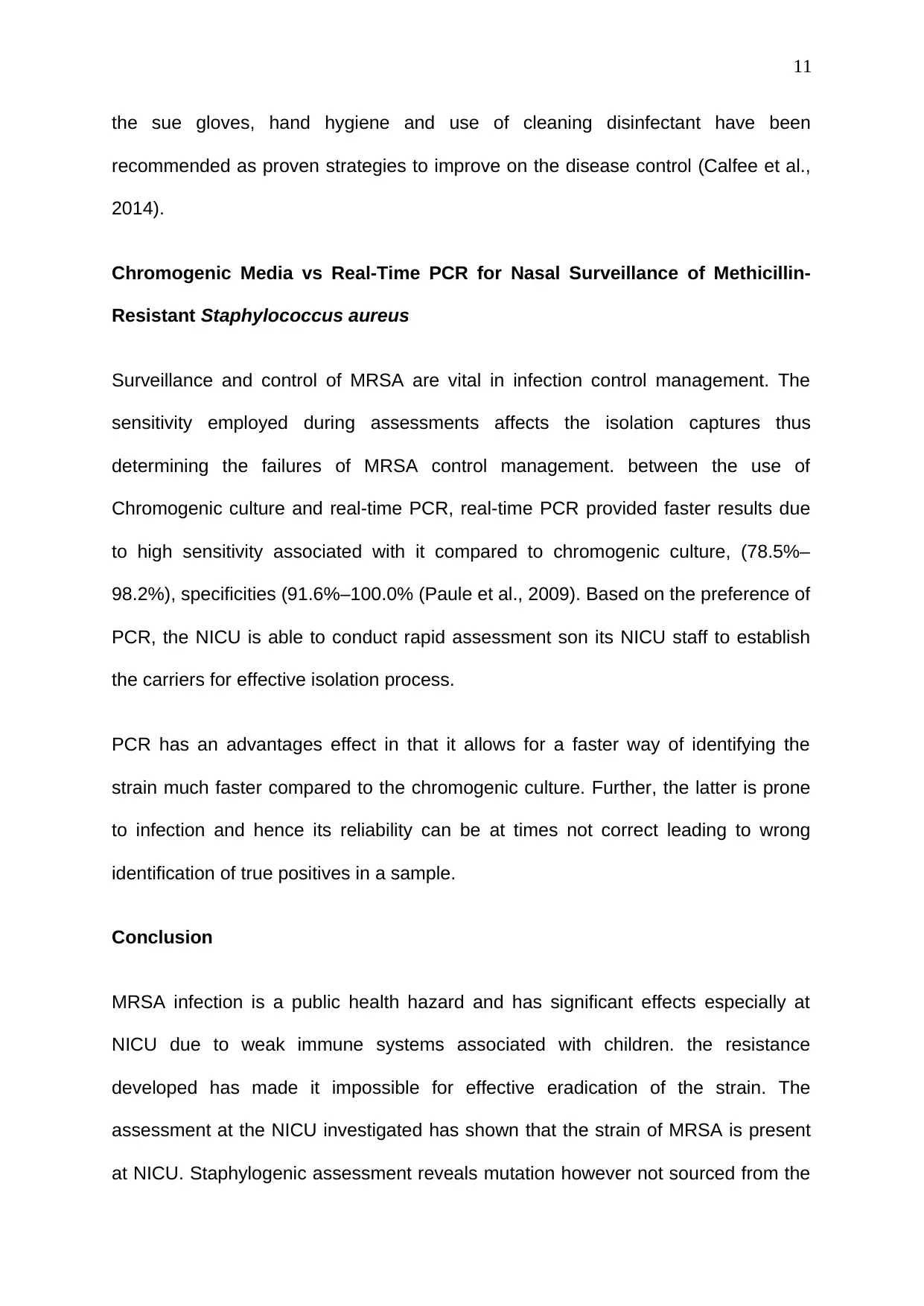
11
the sue gloves, hand hygiene and use of cleaning disinfectant have been
recommended as proven strategies to improve on the disease control (Calfee et al.,
2014).
Chromogenic Media vs Real-Time PCR for Nasal Surveillance of Methicillin-
Resistant Staphylococcus aureus
Surveillance and control of MRSA are vital in infection control management. The
sensitivity employed during assessments affects the isolation captures thus
determining the failures of MRSA control management. between the use of
Chromogenic culture and real-time PCR, real-time PCR provided faster results due
to high sensitivity associated with it compared to chromogenic culture, (78.5%–
98.2%), specificities (91.6%–100.0% (Paule et al., 2009). Based on the preference of
PCR, the NICU is able to conduct rapid assessment son its NICU staff to establish
the carriers for effective isolation process.
PCR has an advantages effect in that it allows for a faster way of identifying the
strain much faster compared to the chromogenic culture. Further, the latter is prone
to infection and hence its reliability can be at times not correct leading to wrong
identification of true positives in a sample.
Conclusion
MRSA infection is a public health hazard and has significant effects especially at
NICU due to weak immune systems associated with children. the resistance
developed has made it impossible for effective eradication of the strain. The
assessment at the NICU investigated has shown that the strain of MRSA is present
at NICU. Staphylogenic assessment reveals mutation however not sourced from the
the sue gloves, hand hygiene and use of cleaning disinfectant have been
recommended as proven strategies to improve on the disease control (Calfee et al.,
2014).
Chromogenic Media vs Real-Time PCR for Nasal Surveillance of Methicillin-
Resistant Staphylococcus aureus
Surveillance and control of MRSA are vital in infection control management. The
sensitivity employed during assessments affects the isolation captures thus
determining the failures of MRSA control management. between the use of
Chromogenic culture and real-time PCR, real-time PCR provided faster results due
to high sensitivity associated with it compared to chromogenic culture, (78.5%–
98.2%), specificities (91.6%–100.0% (Paule et al., 2009). Based on the preference of
PCR, the NICU is able to conduct rapid assessment son its NICU staff to establish
the carriers for effective isolation process.
PCR has an advantages effect in that it allows for a faster way of identifying the
strain much faster compared to the chromogenic culture. Further, the latter is prone
to infection and hence its reliability can be at times not correct leading to wrong
identification of true positives in a sample.
Conclusion
MRSA infection is a public health hazard and has significant effects especially at
NICU due to weak immune systems associated with children. the resistance
developed has made it impossible for effective eradication of the strain. The
assessment at the NICU investigated has shown that the strain of MRSA is present
at NICU. Staphylogenic assessment reveals mutation however not sourced from the
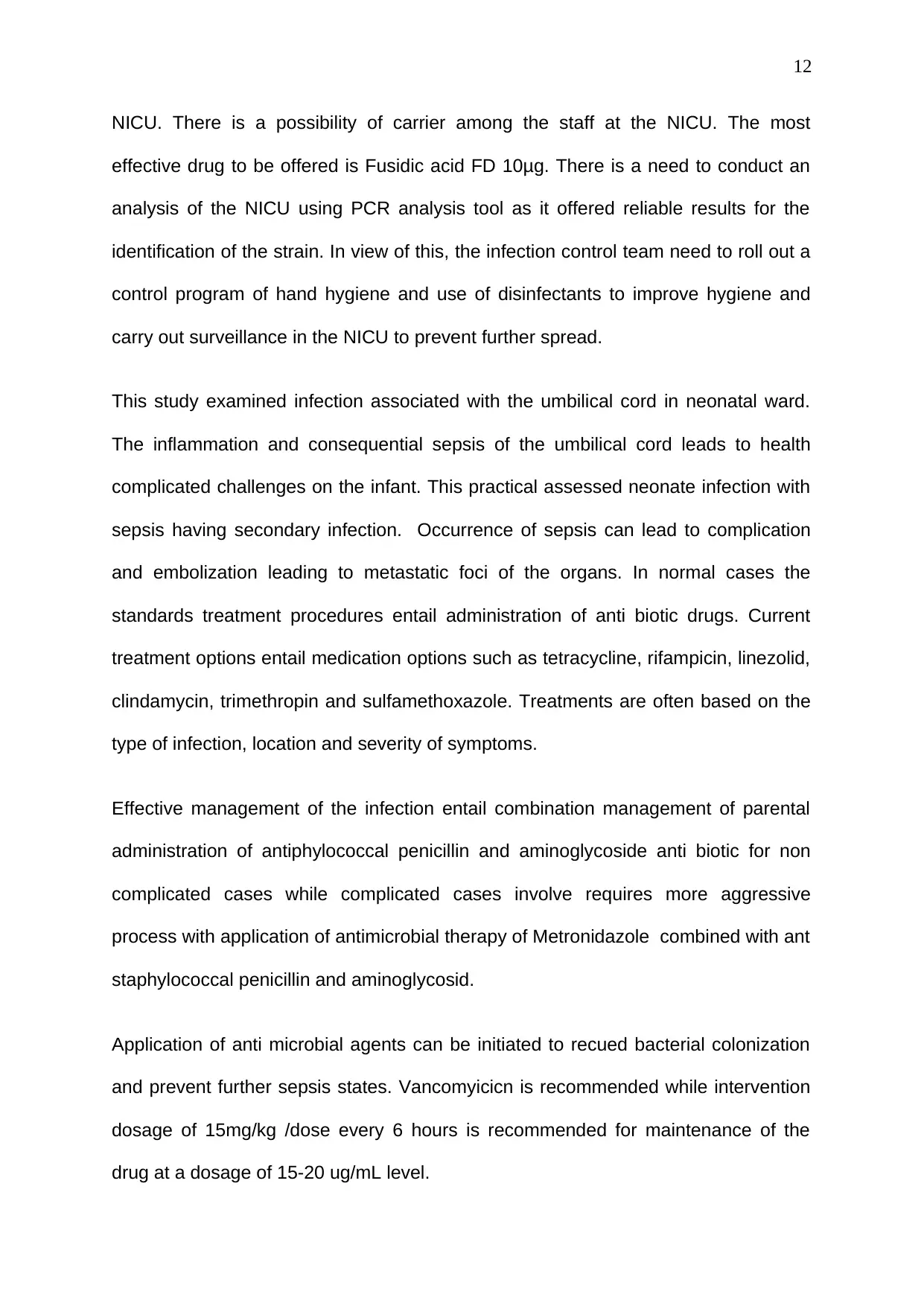
12
NICU. There is a possibility of carrier among the staff at the NICU. The most
effective drug to be offered is Fusidic acid FD 10μg. There is a need to conduct an
analysis of the NICU using PCR analysis tool as it offered reliable results for the
identification of the strain. In view of this, the infection control team need to roll out a
control program of hand hygiene and use of disinfectants to improve hygiene and
carry out surveillance in the NICU to prevent further spread.
This study examined infection associated with the umbilical cord in neonatal ward.
The inflammation and consequential sepsis of the umbilical cord leads to health
complicated challenges on the infant. This practical assessed neonate infection with
sepsis having secondary infection. Occurrence of sepsis can lead to complication
and embolization leading to metastatic foci of the organs. In normal cases the
standards treatment procedures entail administration of anti biotic drugs. Current
treatment options entail medication options such as tetracycline, rifampicin, linezolid,
clindamycin, trimethropin and sulfamethoxazole. Treatments are often based on the
type of infection, location and severity of symptoms.
Effective management of the infection entail combination management of parental
administration of antiphylococcal penicillin and aminoglycoside anti biotic for non
complicated cases while complicated cases involve requires more aggressive
process with application of antimicrobial therapy of Metronidazole combined with ant
staphylococcal penicillin and aminoglycosid.
Application of anti microbial agents can be initiated to recued bacterial colonization
and prevent further sepsis states. Vancomyicicn is recommended while intervention
dosage of 15mg/kg /dose every 6 hours is recommended for maintenance of the
drug at a dosage of 15-20 ug/mL level.
NICU. There is a possibility of carrier among the staff at the NICU. The most
effective drug to be offered is Fusidic acid FD 10μg. There is a need to conduct an
analysis of the NICU using PCR analysis tool as it offered reliable results for the
identification of the strain. In view of this, the infection control team need to roll out a
control program of hand hygiene and use of disinfectants to improve hygiene and
carry out surveillance in the NICU to prevent further spread.
This study examined infection associated with the umbilical cord in neonatal ward.
The inflammation and consequential sepsis of the umbilical cord leads to health
complicated challenges on the infant. This practical assessed neonate infection with
sepsis having secondary infection. Occurrence of sepsis can lead to complication
and embolization leading to metastatic foci of the organs. In normal cases the
standards treatment procedures entail administration of anti biotic drugs. Current
treatment options entail medication options such as tetracycline, rifampicin, linezolid,
clindamycin, trimethropin and sulfamethoxazole. Treatments are often based on the
type of infection, location and severity of symptoms.
Effective management of the infection entail combination management of parental
administration of antiphylococcal penicillin and aminoglycoside anti biotic for non
complicated cases while complicated cases involve requires more aggressive
process with application of antimicrobial therapy of Metronidazole combined with ant
staphylococcal penicillin and aminoglycosid.
Application of anti microbial agents can be initiated to recued bacterial colonization
and prevent further sepsis states. Vancomyicicn is recommended while intervention
dosage of 15mg/kg /dose every 6 hours is recommended for maintenance of the
drug at a dosage of 15-20 ug/mL level.
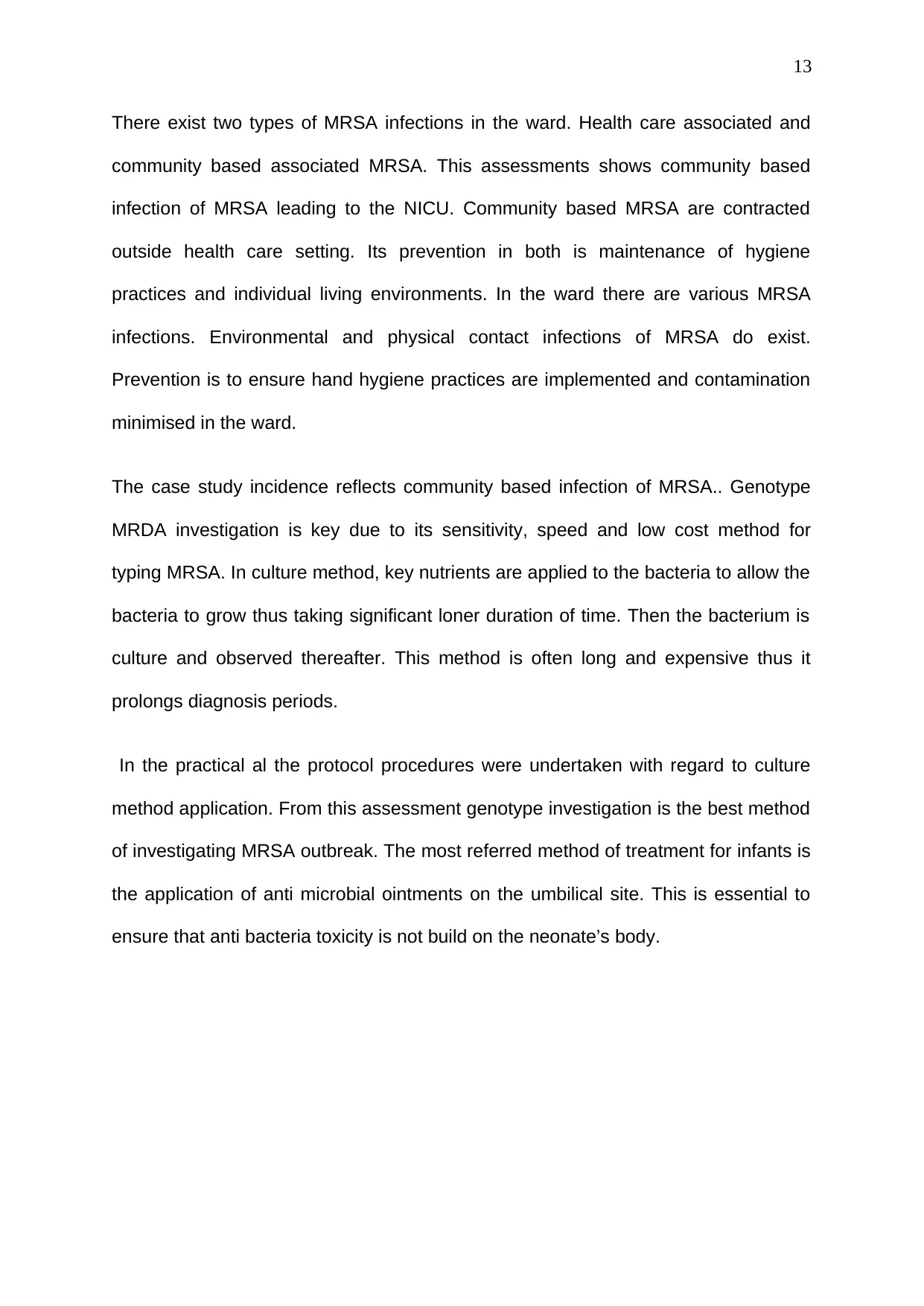
13
There exist two types of MRSA infections in the ward. Health care associated and
community based associated MRSA. This assessments shows community based
infection of MRSA leading to the NICU. Community based MRSA are contracted
outside health care setting. Its prevention in both is maintenance of hygiene
practices and individual living environments. In the ward there are various MRSA
infections. Environmental and physical contact infections of MRSA do exist.
Prevention is to ensure hand hygiene practices are implemented and contamination
minimised in the ward.
The case study incidence reflects community based infection of MRSA.. Genotype
MRDA investigation is key due to its sensitivity, speed and low cost method for
typing MRSA. In culture method, key nutrients are applied to the bacteria to allow the
bacteria to grow thus taking significant loner duration of time. Then the bacterium is
culture and observed thereafter. This method is often long and expensive thus it
prolongs diagnosis periods.
In the practical al the protocol procedures were undertaken with regard to culture
method application. From this assessment genotype investigation is the best method
of investigating MRSA outbreak. The most referred method of treatment for infants is
the application of anti microbial ointments on the umbilical site. This is essential to
ensure that anti bacteria toxicity is not build on the neonate’s body.
There exist two types of MRSA infections in the ward. Health care associated and
community based associated MRSA. This assessments shows community based
infection of MRSA leading to the NICU. Community based MRSA are contracted
outside health care setting. Its prevention in both is maintenance of hygiene
practices and individual living environments. In the ward there are various MRSA
infections. Environmental and physical contact infections of MRSA do exist.
Prevention is to ensure hand hygiene practices are implemented and contamination
minimised in the ward.
The case study incidence reflects community based infection of MRSA.. Genotype
MRDA investigation is key due to its sensitivity, speed and low cost method for
typing MRSA. In culture method, key nutrients are applied to the bacteria to allow the
bacteria to grow thus taking significant loner duration of time. Then the bacterium is
culture and observed thereafter. This method is often long and expensive thus it
prolongs diagnosis periods.
In the practical al the protocol procedures were undertaken with regard to culture
method application. From this assessment genotype investigation is the best method
of investigating MRSA outbreak. The most referred method of treatment for infants is
the application of anti microbial ointments on the umbilical site. This is essential to
ensure that anti bacteria toxicity is not build on the neonate’s body.
Paraphrase This Document
Need a fresh take? Get an instant paraphrase of this document with our AI Paraphraser
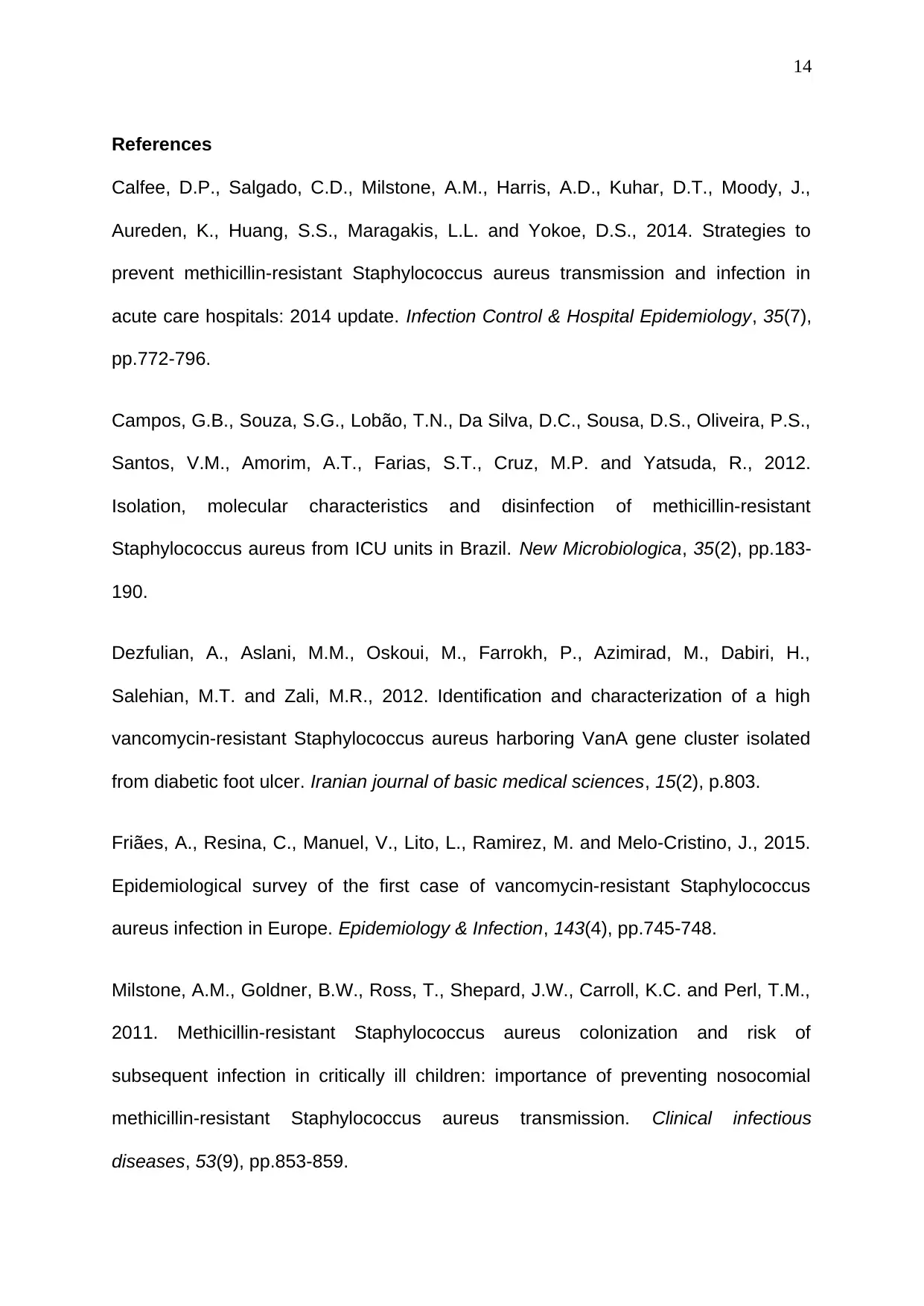
14
References
Calfee, D.P., Salgado, C.D., Milstone, A.M., Harris, A.D., Kuhar, D.T., Moody, J.,
Aureden, K., Huang, S.S., Maragakis, L.L. and Yokoe, D.S., 2014. Strategies to
prevent methicillin-resistant Staphylococcus aureus transmission and infection in
acute care hospitals: 2014 update. Infection Control & Hospital Epidemiology, 35(7),
pp.772-796.
Campos, G.B., Souza, S.G., Lobão, T.N., Da Silva, D.C., Sousa, D.S., Oliveira, P.S.,
Santos, V.M., Amorim, A.T., Farias, S.T., Cruz, M.P. and Yatsuda, R., 2012.
Isolation, molecular characteristics and disinfection of methicillin-resistant
Staphylococcus aureus from ICU units in Brazil. New Microbiologica, 35(2), pp.183-
190.
Dezfulian, A., Aslani, M.M., Oskoui, M., Farrokh, P., Azimirad, M., Dabiri, H.,
Salehian, M.T. and Zali, M.R., 2012. Identification and characterization of a high
vancomycin-resistant Staphylococcus aureus harboring VanA gene cluster isolated
from diabetic foot ulcer. Iranian journal of basic medical sciences, 15(2), p.803.
Friães, A., Resina, C., Manuel, V., Lito, L., Ramirez, M. and Melo-Cristino, J., 2015.
Epidemiological survey of the first case of vancomycin-resistant Staphylococcus
aureus infection in Europe. Epidemiology & Infection, 143(4), pp.745-748.
Milstone, A.M., Goldner, B.W., Ross, T., Shepard, J.W., Carroll, K.C. and Perl, T.M.,
2011. Methicillin-resistant Staphylococcus aureus colonization and risk of
subsequent infection in critically ill children: importance of preventing nosocomial
methicillin-resistant Staphylococcus aureus transmission. Clinical infectious
diseases, 53(9), pp.853-859.
References
Calfee, D.P., Salgado, C.D., Milstone, A.M., Harris, A.D., Kuhar, D.T., Moody, J.,
Aureden, K., Huang, S.S., Maragakis, L.L. and Yokoe, D.S., 2014. Strategies to
prevent methicillin-resistant Staphylococcus aureus transmission and infection in
acute care hospitals: 2014 update. Infection Control & Hospital Epidemiology, 35(7),
pp.772-796.
Campos, G.B., Souza, S.G., Lobão, T.N., Da Silva, D.C., Sousa, D.S., Oliveira, P.S.,
Santos, V.M., Amorim, A.T., Farias, S.T., Cruz, M.P. and Yatsuda, R., 2012.
Isolation, molecular characteristics and disinfection of methicillin-resistant
Staphylococcus aureus from ICU units in Brazil. New Microbiologica, 35(2), pp.183-
190.
Dezfulian, A., Aslani, M.M., Oskoui, M., Farrokh, P., Azimirad, M., Dabiri, H.,
Salehian, M.T. and Zali, M.R., 2012. Identification and characterization of a high
vancomycin-resistant Staphylococcus aureus harboring VanA gene cluster isolated
from diabetic foot ulcer. Iranian journal of basic medical sciences, 15(2), p.803.
Friães, A., Resina, C., Manuel, V., Lito, L., Ramirez, M. and Melo-Cristino, J., 2015.
Epidemiological survey of the first case of vancomycin-resistant Staphylococcus
aureus infection in Europe. Epidemiology & Infection, 143(4), pp.745-748.
Milstone, A.M., Goldner, B.W., Ross, T., Shepard, J.W., Carroll, K.C. and Perl, T.M.,
2011. Methicillin-resistant Staphylococcus aureus colonization and risk of
subsequent infection in critically ill children: importance of preventing nosocomial
methicillin-resistant Staphylococcus aureus transmission. Clinical infectious
diseases, 53(9), pp.853-859.
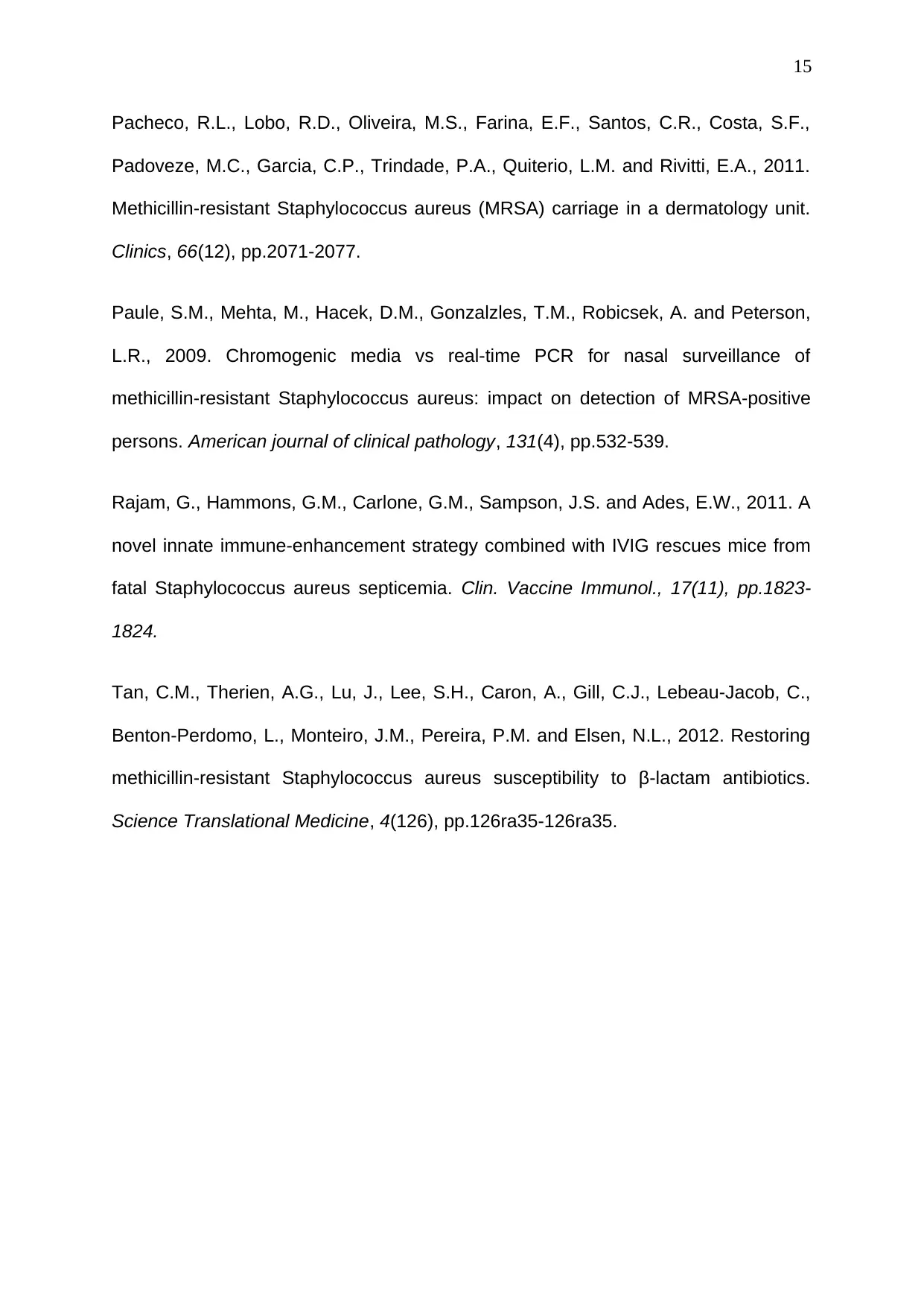
15
Pacheco, R.L., Lobo, R.D., Oliveira, M.S., Farina, E.F., Santos, C.R., Costa, S.F.,
Padoveze, M.C., Garcia, C.P., Trindade, P.A., Quiterio, L.M. and Rivitti, E.A., 2011.
Methicillin-resistant Staphylococcus aureus (MRSA) carriage in a dermatology unit.
Clinics, 66(12), pp.2071-2077.
Paule, S.M., Mehta, M., Hacek, D.M., Gonzalzles, T.M., Robicsek, A. and Peterson,
L.R., 2009. Chromogenic media vs real-time PCR for nasal surveillance of
methicillin-resistant Staphylococcus aureus: impact on detection of MRSA-positive
persons. American journal of clinical pathology, 131(4), pp.532-539.
Rajam, G., Hammons, G.M., Carlone, G.M., Sampson, J.S. and Ades, E.W., 2011. A
novel innate immune-enhancement strategy combined with IVIG rescues mice from
fatal Staphylococcus aureus septicemia. Clin. Vaccine Immunol., 17(11), pp.1823-
1824.
Tan, C.M., Therien, A.G., Lu, J., Lee, S.H., Caron, A., Gill, C.J., Lebeau-Jacob, C.,
Benton-Perdomo, L., Monteiro, J.M., Pereira, P.M. and Elsen, N.L., 2012. Restoring
methicillin-resistant Staphylococcus aureus susceptibility to β-lactam antibiotics.
Science Translational Medicine, 4(126), pp.126ra35-126ra35.
Pacheco, R.L., Lobo, R.D., Oliveira, M.S., Farina, E.F., Santos, C.R., Costa, S.F.,
Padoveze, M.C., Garcia, C.P., Trindade, P.A., Quiterio, L.M. and Rivitti, E.A., 2011.
Methicillin-resistant Staphylococcus aureus (MRSA) carriage in a dermatology unit.
Clinics, 66(12), pp.2071-2077.
Paule, S.M., Mehta, M., Hacek, D.M., Gonzalzles, T.M., Robicsek, A. and Peterson,
L.R., 2009. Chromogenic media vs real-time PCR for nasal surveillance of
methicillin-resistant Staphylococcus aureus: impact on detection of MRSA-positive
persons. American journal of clinical pathology, 131(4), pp.532-539.
Rajam, G., Hammons, G.M., Carlone, G.M., Sampson, J.S. and Ades, E.W., 2011. A
novel innate immune-enhancement strategy combined with IVIG rescues mice from
fatal Staphylococcus aureus septicemia. Clin. Vaccine Immunol., 17(11), pp.1823-
1824.
Tan, C.M., Therien, A.G., Lu, J., Lee, S.H., Caron, A., Gill, C.J., Lebeau-Jacob, C.,
Benton-Perdomo, L., Monteiro, J.M., Pereira, P.M. and Elsen, N.L., 2012. Restoring
methicillin-resistant Staphylococcus aureus susceptibility to β-lactam antibiotics.
Science Translational Medicine, 4(126), pp.126ra35-126ra35.
1 out of 15
Related Documents
Your All-in-One AI-Powered Toolkit for Academic Success.
+13062052269
info@desklib.com
Available 24*7 on WhatsApp / Email
![[object Object]](/_next/static/media/star-bottom.7253800d.svg)
Unlock your academic potential
© 2024 | Zucol Services PVT LTD | All rights reserved.



